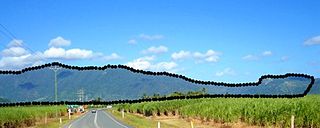
Australian Aboriginal religion and mythology is the sacred spirituality represented in the stories performed by Aboriginal Australians within each of the language groups across Australia in their ceremonies. Aboriginal spirituality includes the Dreamtime, songlines, and Aboriginal oral literature.

The Dreaming, also referred to as Dreamtime, is a term devised by early anthropologists to refer to a religio-cultural worldview attributed to Australian Aboriginal beliefs. It was originally used by Francis Gillen, quickly adopted by his colleague Baldwin Spencer and thereafter popularised by A. P. Elkin, who, however, later revised his views. The Dreaming is used to represent Aboriginal concepts of Everywhen during which the land was inhabited by ancestral figures, often of heroic proportions or with supernatural abilities. These figures were often distinct from gods as they did not control the material world and were not worshipped, but only revered. The concept of the Dreamtime has subsequently become widely adopted beyond its original Australian context and is now part of global popular culture.
Baralku, also written Burralku or Bralgu, is a place connected with creation ancestors in the mythology of the Yolngu people of Arnhem Land in the Northern Territory of Australia. It is referred to as island of the dead, and the place where the ancestors known as Djanggawul (Djan'kawu) originated, before travelling by canoe to Yalangbara, where they gave birth to the Rirratjingu clan.
The Wawalag sisters, also written as WauwalukWawilakWaggilak, Wagilag, or Wawalik, are ancestral creator beings whose story is part of "the most widespread" sacred rituals in the Aboriginal culture from Arnhem land, Northern Territory, Australia. Their story takes place in Dreamtime, a period of time in Aboriginal belief where ancestral beings created the land as well as the social and linguistic structures in it. The sisters are said to have helped draw linguistic and social differences amongst the clans in Arnhem Land, but the ceremonies associated with their stories create cultural unity.
The Mabuiag, or Mabuygiwgal, are an Indigenous Australian group of Torres Strait Islander people united by a common language, strong ties of kinship and survived as skilled hunter–fisher–gatherers in family groups or clans living on a number of Torres Strait Islands including Mabuiag Island, in the Torres Strait in Queensland, Australia. They are ethnically Melanesian.

The Yolngu or Yolŋu are an aggregation of Aboriginal Australian people inhabiting north-eastern Arnhem Land in the Northern Territory of Australia. Yolngu means "person" in the Yolŋu languages. The terms Murngin, Wulamba, Yalnumata, Murrgin and Yulangor were formerly used by some anthropologists for the Yolngu.

The Ngarrindjeri people are the traditional Aboriginal Australian people of the lower Murray River, eastern Fleurieu Peninsula, and the Coorong of the southern-central area of the state of South Australia. The term ngarrindjeri means "belonging to men", and refers to a "tribal constellation". The Ngarrindjeri actually comprised several distinct if closely related tribal groups, including the Jarildekald, Tanganekald, Meintangk and Ramindjeri, who began to form a unified cultural bloc after remnants of each separate community congregated at Raukkan, South Australia.

The Rainbow Serpent or Rainbow Snake is a common deity often seen as a creator god, known by numerous names in different Australian Aboriginal languages by the many different Aboriginal peoples. It a common motif in the art and religion of many Aboriginal Australian peoples.
Diane Robin (Di) Bell is an Australian feminist anthropologist, author and activist. She is Professor Emerita of Anthropology at the George Washington University in Washington, D.C, USA and Distinguished Honorary Professor of Anthropology at the Australian National University, Canberra. Her work focuses on the Aboriginal people of Australia, Indigenous land rights, human rights, Indigenous religions, violence against women, and on environmental issues.
Ronald Murray Berndt was an Australian social anthropologist who, in 1963, became the inaugural professor of anthropology at the University of Western Australia.
Baijini are a race of people, mythical or historical, mentioned in the Djanggawul song cycle of the Yolngu people, an Aboriginal Australian people of Arnhem Land in the Northern Territory.
The Nangiomeri, or Nanggumiri, were an indigenous Australian people who lived in the area of the Daly River in the Northern Territory.
The Maraura or Marrawarra people are an Aboriginal group whose traditional lands are located in Far West New South Wales and South Australia, Australia.
The Maung people, or Warruwi, are an Aboriginal Australian people living on the Goulburn Islands, in the Arafura sea off the coast of the Northern Territory.
The Bininj are an Aboriginal Australian people of Western Arnhem land in the Northern Territory. The sub-groups of Bininj are sometimes referred to by the various language dialects spoken in the region, that is, the group of dialects known as Bininj Gun-Wok; so the people may be named Gunwinggu, the Kuninjku, Kundjeyhmi (Gundjeihmi), Manyallaluk Mayali, Kundedjnjenghmi and Kune groups. In addition, there are clan groups such as the Mirrar who are prominent in matters relating to looking after the traditional lands.
The Nunggubuyu are an Aboriginal Australian people of eastern Arnhem Land in the Northern Territory.
The Bodaruwitj, also rendered Bedaruwidj or Potaruwutj, and referred to in some early sources as the Tatiara, are an Aboriginal Australian people of the state of South Australia. Some authorities believe they are extinct. David Horton believed they were the group his sources referred to as the Bindjali people. Austlang refers to Bindjali / Bodaruwitj as alternative names for the same language.
The Mangarayi, also written Mangarai, were an indigenous Australian people of the Northern Territory.
The Biyaygiri, also known as Bandjin, were an Aboriginal Australian people of northern Queensland.
The Yunggor were an Aboriginal Australian people of the Northern Territory.





